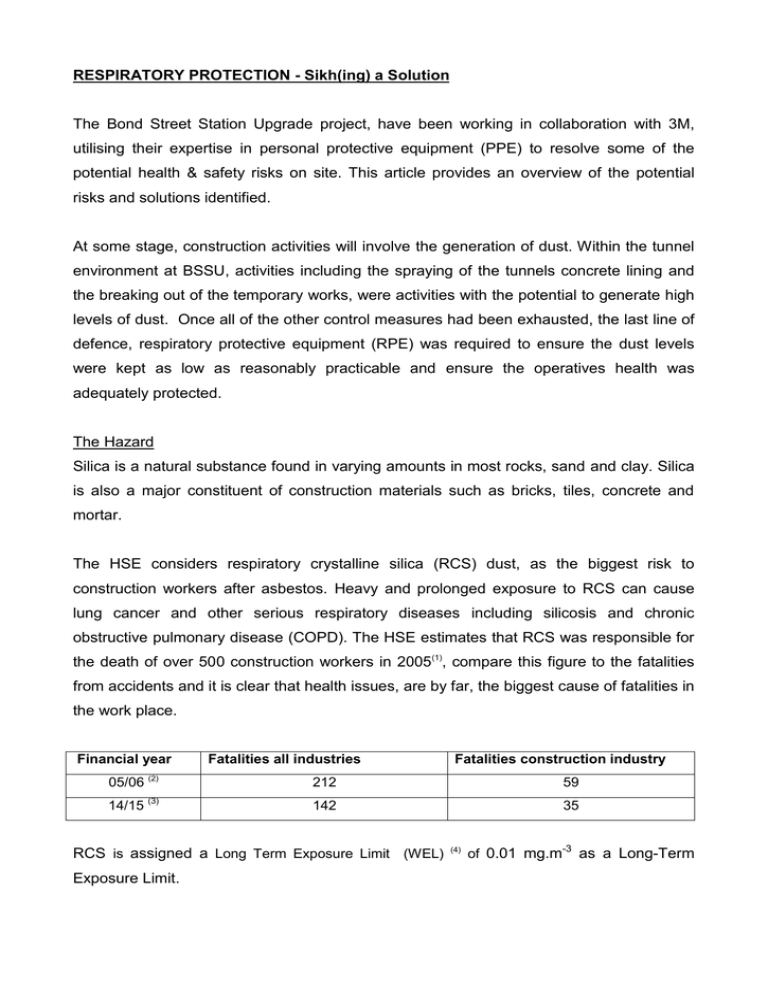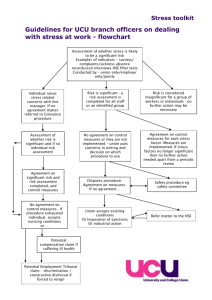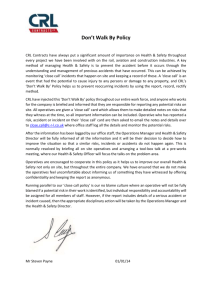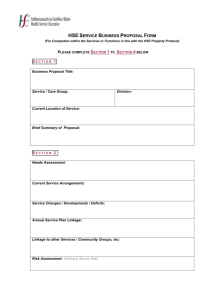to - Best Practice Hub
advertisement

RESPIRATORY PROTECTION - Sikh(ing) a Solution The Bond Street Station Upgrade project, have been working in collaboration with 3M, utilising their expertise in personal protective equipment (PPE) to resolve some of the potential health & safety risks on site. This article provides an overview of the potential risks and solutions identified. At some stage, construction activities will involve the generation of dust. Within the tunnel environment at BSSU, activities including the spraying of the tunnels concrete lining and the breaking out of the temporary works, were activities with the potential to generate high levels of dust. Once all of the other control measures had been exhausted, the last line of defence, respiratory protective equipment (RPE) was required to ensure the dust levels were kept as low as reasonably practicable and ensure the operatives health was adequately protected. The Hazard Silica is a natural substance found in varying amounts in most rocks, sand and clay. Silica is also a major constituent of construction materials such as bricks, tiles, concrete and mortar. The HSE considers respiratory crystalline silica (RCS) dust, as the biggest risk to construction workers after asbestos. Heavy and prolonged exposure to RCS can cause lung cancer and other serious respiratory diseases including silicosis and chronic obstructive pulmonary disease (COPD). The HSE estimates that RCS was responsible for the death of over 500 construction workers in 2005(1), compare this figure to the fatalities from accidents and it is clear that health issues, are by far, the biggest cause of fatalities in the work place. Financial year Fatalities all industries Fatalities construction industry 05/06 (2) 212 59 14/15 (3) 142 35 RCS is assigned a Long Term Exposure Limit (WEL) Exposure Limit. (4) of 0.01 mg.m-3 as a Long-Term The amounts needed to cause damage are minute; the HSE states, ‘that the most you should be inhaling during a day after using the right controls is shown next to the penny (5). The Challenge BSSU, have undertaken extensive work to control dust on site and to find suitable Respiratory Protective Equipment (RPE). A particular problem that required a solution was to identify suitable RPE, that could be worn by operatives who have beards, coinciding with religious and cultural beliefs. The RPE also needed to offer as a minimum, a Protection Factor 20 and needed to be worn with a turban. Once all of this was achieved the RPE, needed to be comfortable and accepted by the operatives, with the importance to focus on the ‘want to wear’, not ‘have to wear’ perception. The project contacted, the National Construction Specialist at 3M. With the support of 3M, an air fed respirator, known as a ‘Versaflow’, complete with a soft hood, was identified, as a possible solution. Versaflow belt pack Soft Hood (S533) On-site trials were conducted to ensure the suitability of the RPE in the working environment and allowing an opportunity for operatives to provide feedback. 3M also delivered on site training on to correctly use, how maintain the store and Versaflow, RPE. BSSU operative wearing the versaflow complete with soft hood. Feedback from operatives has been positive, with comments such as “the system is comfortable and protects my lungs’. Benefits Adequate level of protection maintained, enabling trained and skilled operatives in the working environment, reducing cost associated with operative turnover and the loss of experience. Each operative was provided individual respirators and hoods, but as the Versaflow is sold as component parts, cost savings were made by sharing the battery packs across each shift. Additionally using replaceable parts allows simple maintenance on site. Enhancing the organisations image as a caring and diverse employer. Improving engagement and reinforcing the health & safety culture, through working with site operatives to find a suitable solution. References 1. http://www.hse.gov.uk/construction/healthrisks/cancer-and-construction/silicadust.htm, accessed on 19/11/15 2. Health & safety statistics 2005/2006 HSC 2006 3. Health & safety statistics, annual report for Great Britain 2014/15 HSE 2015 4. EH40/2005 HSE 2011 5. Construction Information (CIS) Sheet No 36 (Rev 2) HSE 2013


